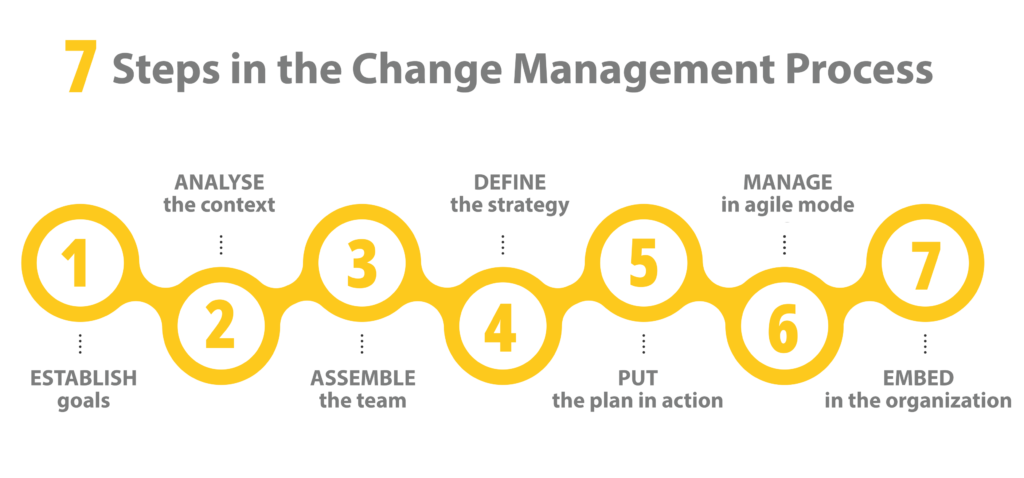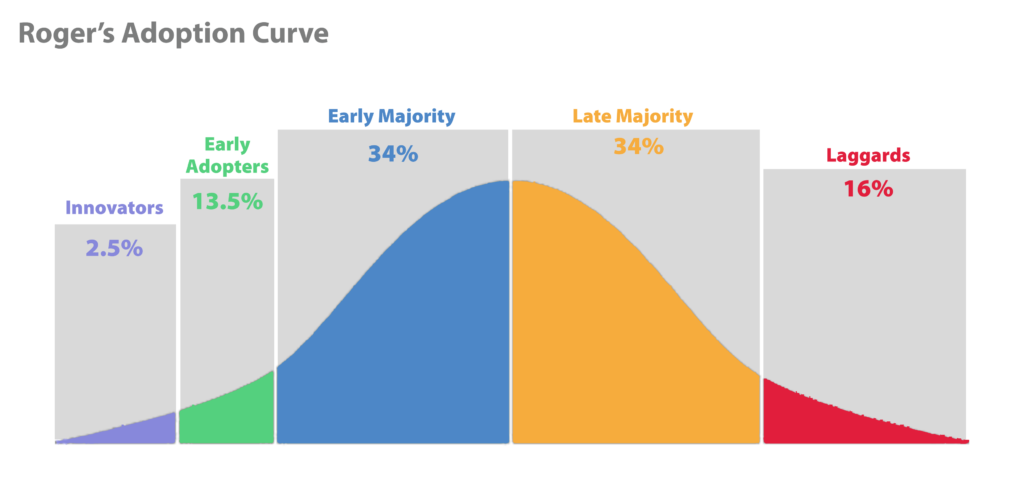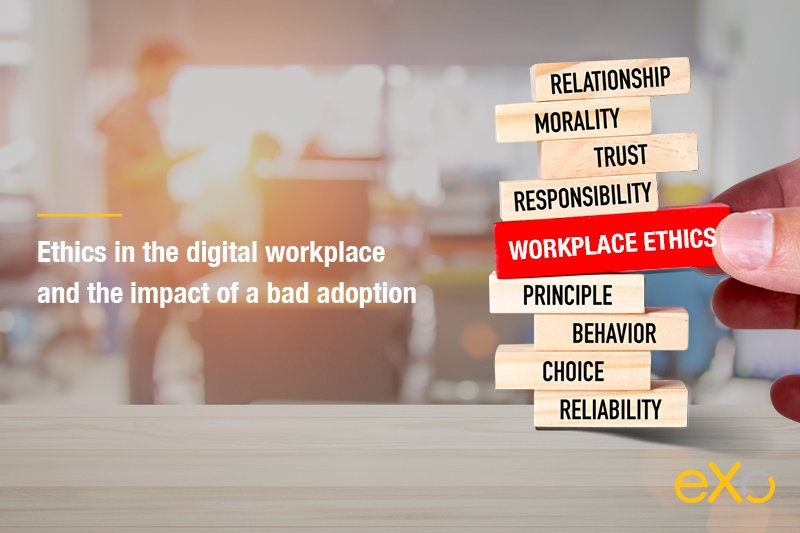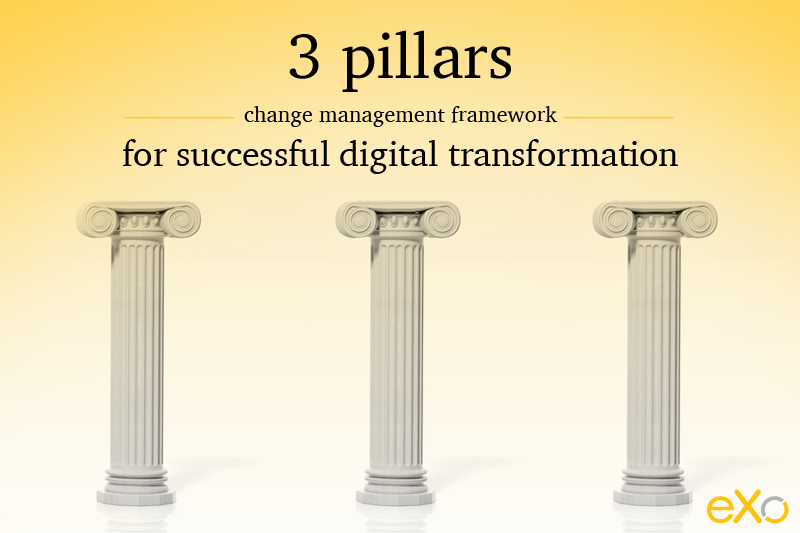- Veronika Mazour
- March 21, 2022
7 steps for successful change management process

Content
Below is our simple and practical 7-step recipe for successful change management, relevant for your digital workplace project but also any other strategic project, digital or otherwise.

1. Establish your goals
The first step is to establish and clarify your goals. Even though it sounds generic and commonplace, this step is essential to your overall success. Ask yourself, what is the ultimate goal of your underlying project. To increase your topline? Decrease your bottom line? Improve your client satisfaction? Win a new market?
Are your goals more financial, sales oriented, linked to human resources? And how would you measure your success? What measurable indicators can you use to establish whether your project is followingthe desired trajectory?
At the end of this step, you should be able to clearly express your main goal and any associated success indicators, particularly if you are using change management software. Enrolling in a Change Management Certification Course can further equip you with strategies to effectively implement and communicate these goals across your team.
2. Identify your constraints
This step is about analyzing your organization’s current context and the impact the change would bring. Depending on step 1, the analysis can highlight your organization’s market position, competition, values and culture, internal organization…. The goal is to identify impacts and potential constraints to change in relation to the above dimensions.
Constraints are better identified, and relevant solutions found, through a team effort assembling key stakeholders – people from the functions that the change would most impact. That team effort would also benefit your change management process by ensuring your stakeholders’ cooperation. Utilizing a multi-project management software can facilitate collaboration and streamline communication among team members, enabling efficient coordination of tasks and ensuring effective change management.
discover all the features and benefits
3. Assemble your dream team
Change doesn’t happen overnight, nor is it adopted by everyone from the get-go. Everett Rogers studied how innovation spreads in the farming industry and formalized his theory in a book called Diffusion of Innovations (1962). Today, the diffusion of innovations is largely used when dealing with change in any sector.
Let’s brush up on this real quick. Rogers categorizes people into five categories according to their inclination to try and adopt an innovation (a change): innovators, early adopters, early majority, late majority and laggards. In a nutshell:
- Innovators (2.5% of your organization) are the risk takers, driving the change.
- Early adopters (13.5% of your organization) are opinion leaders – popular people that would try out new ideas.
- Early majority (34%) are more careful but would accept change quicker than average.
- Late majority (34%) are sceptical people who would adopt the change when the majority does.
- Laggards (16%) are traditional people, attached to the “old ways”. They would only adopt new ideas when the latter become mainstream or even tradition.
It needs to represent the business functions that would be affected by the change (your pilot groups and/or the groups key to the overall success as per step 1)
It needs to be mostly composed of innovators and early adopters.

4. Define your strategy and action plan
Rogers also defined a five-stage model for the diffusion of innovation at each person’s level: knowledge, persuasion, decision, implementation and confirmation.
Each person needs to follow all five stages before adopting the change. We start by being made aware of the innovation – we learn about the change (knowledge). We then become convinced of its value (persuasion). We decide to adopt the change (decision). We start putting it into practice (implementation). Finally, we accept (or reject) the change (confirmation).
Your goal, when introducing something new, is to gradually pass all your employees through this cycle, starting with the most risk friendly (innovators).
In this ever-evolving digital landscape, it’s crucial to stay updated with the latest trends and platforms. A prime example of a game-changing innovation can be seen in the rise of webflow development. Webflow is a groundbreaking platform that empowers businesses to build professional, responsive websites without the need for extensive coding knowledge. By embracing webflow migrations, companies can streamline their digital operations, reduce reliance on traditional web development, and ultimately foster a more dynamic and efficient digital ecosystem.
Keeping that in mind, you need to define a strategy to communicate around the change and explain its goals and benefits. When changes occur, such as updates to a process or new tasks that need to be completed, the workflow management software can be used to ensure that all team members are informed. You might want to encourage commitment using rewards and perks, especially for the early adopters. You need to design implementation steps that would ease the practice of the change for your organization.
5. Put your plan into action
Once you’ve define your strategy and your action plan, you need to put it into practice, starting with internal communications around change.
6. Keep at it in agile mode
Change is a lengthy process that requires continuous efforts and perseverance from the change management team.
Indeed, different people from your organization will follow a different rhythm with regards to change. As your innovators and early adopters might be at stage 5 (confirmation) of their journey, your early majority might be at stage 1 and require you to focus on awareness and value communication. Your action plan might need to be adjusted gradually, following your change management process and your initial feedbacks. In-app support can be a valuable resource during this process, allowing you to quickly and easily communicate with your users and gather feedback. After the first positive results, new goals might be defined to deepen the change….-
The only way to succeed is by following the principles of an agile manifesto, constantly reviewing and adapting, and always looking for ways to improve. Relying on your key performance indicators of success (step 1) will help you follow your progress.
Communicate around your result and success to help promote the change to new users.
7. Embed it into the organization
Once your innovation is adopted by most (innovators, early adopters, early majority and first late majority users), it is time to make it mainstream. This step requires you to document the best of your change practices and incorporate them into your company rules and policies.
Communicating around the results at this stage also helps demonstrate value in your change management and the fact that change has become an inherent part of the organization.
tools and information
FAQ
What are the steps for successful change management process?
- Establish your goals
- Identify your constraints
- Assemble your dream team
- Define your strategy and action plan
- Put your plan into action
- Keep at it in agile mode
- Embed it into the organization
Related posts
- All
- eXo
- Digital workplace
- Employee engagement
- Open source
- Future of work
- Internal communication
- Collaboration
- News
- intranet
- workplace
- Knowledge management
- Employee experience
- Employee productivity
- onboarding
- Employee recognition
- Change management
- Cartoon
- Digital transformation
- Infographic
- Remote work
- Industry trends
- Product News
- Thought leadership
- Tips & Tricks
- Tutorial
- Uncategorized
Leave a Reply
( Your e-mail address will not be published)

